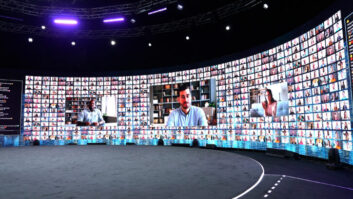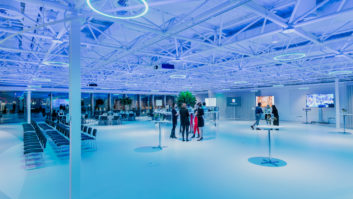From the surge in demand for HDR to the huge creative opportunities heralded by AI, there has been no shortage of technology trends to get enthused about in recent years. But in terms of its impact across multiple sectors, the growing convergence between broadcast and AV technologies has to be one of the most significant.

Relatively speaking, it’s still quite a new development. Traditionally, broadcast video and the AV industry have catered to different markets; broadcast is focused on live television, film production and high quality media delivery to a huge audience, while AV is centred on things like corporate presentations, digital signage and event staging. That has also tended to result in different orders of priority, with broadcast focused on quality, reliability and regulatory compliance, and AV more concentrated on the actual experience, interactivity, and flexibility for different environments.
The divide between the two sectors could be seen clearly in its approach to operational and technical standards. Thanks to the size of the audiences involved, broadcast has long had to adhere to strict benchmarks like the ATSC standards. However, in AV, standards efforts have largely been vendor-driven and so there has been a broader range of approaches, with factors including ease of use and integration with IT networks proving to be very important.
For the last five years at least, though, the historic separation between broadcast and AV has begun to dissolve. For one thing, broadcast-grade equipment has become increasingly accessible to other sectors. It’s now very common to go into a corporate environment and encounter an AV presentation & collaboration set-up with capabilities that resemble a full-on production studio. Then you have the whole area of crossover between the way that content is being consumed, with people using their laptops and mobile devices to work on remotely and stream their favourite TV shows.
But arguably the most important single development has been the shift toward an IP-based network infrastructure in broadcast and AV. For the first time, both sectors are increasingly operating from the same kind of IT foundations. Then you have the growing awareness of the SMPTE ST 2110 IP media standards, which control and define how audio, video and control data are transmitted across the network. It’s so well-organised that it makes sense for both AV and broadcast to use the same standards, and so you now see everything from small post studios to large broadcast centres, houses of worship and conference centres all looking at ST 2110.

Moreover, as the technologies have become more accessible, the prices of 10 and 25GbE routers and switches – which make ST 2110 more available to everyone – have steadily come down. The trend has led to several significant recent product launches for AJA, including KONA IP25, our next-gen IP video and audio PCIe I/O card with 10/25GbE SFP connectivity, multi-channel UltraHD support, and a host of other features designed to accommodate full and hybrid ST 2110 ecosystems in both broadcast and AV environments.
There’s also a lot of convergence taking place in terms of I/O and conversion. At AJA we’ve noticed that AV customers increasingly require the capabilities of a product like our BRIDGE LIVE IP video workflow bridge, which provides the ability to take in multiple video feeds, encode them in multiple formats, and then deliver them in different ways. It bridges IP streams and baseband in both directions, and then we also have another version, BRIDGE NDI, that offers high-density conversion from 3G-SDI to NDI, and NDI to 3G-SDI, for both HD and 4K/UHD. In both cases, we have exciting new features that I think will really excite people at ISE.
A further sign of the convergence is that the conversations we’ve been having at ISE in recent years have become more and more like those we have at NAB and IBC. So, all in all, I am really excited about what we’re going to see at ISE 2025. It’s a super-creative time for us and other vendors that find themselves in the intersection between broadcast and AV, and I think there’s a huge amount of innovation that we can all look forward to.







